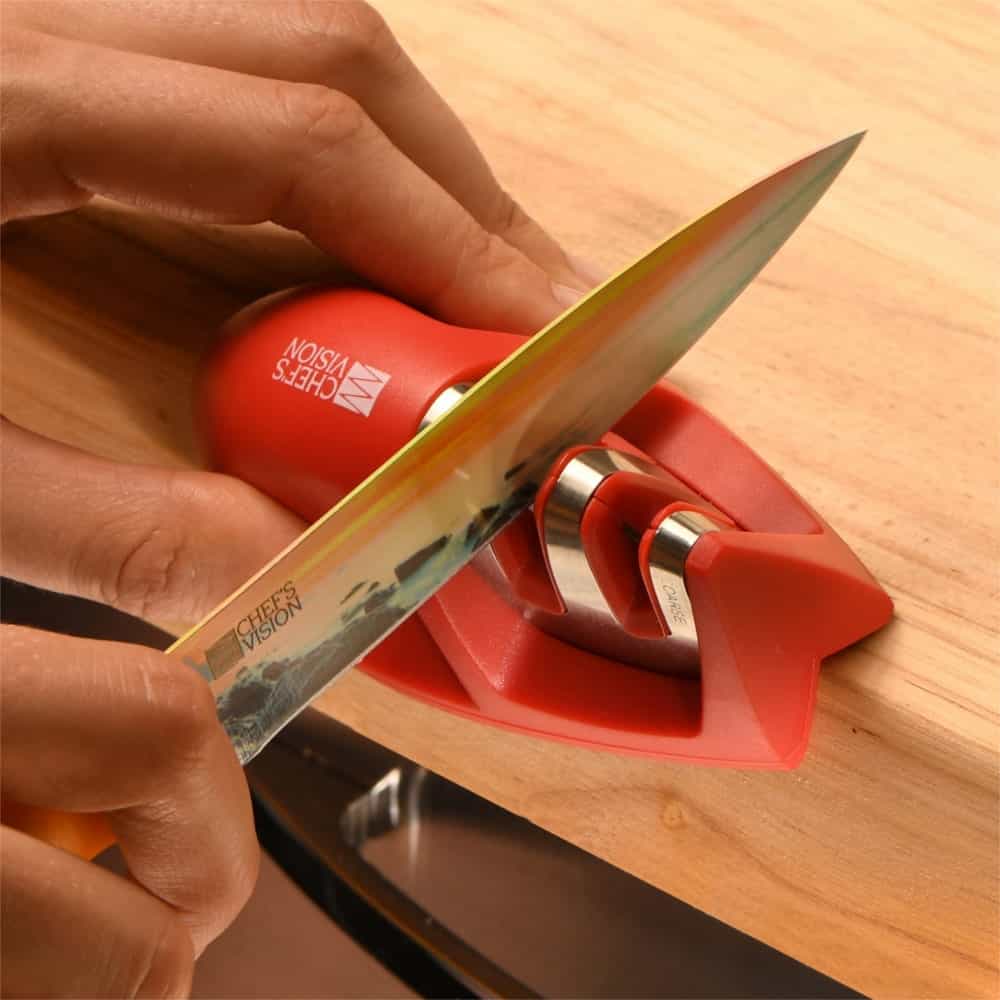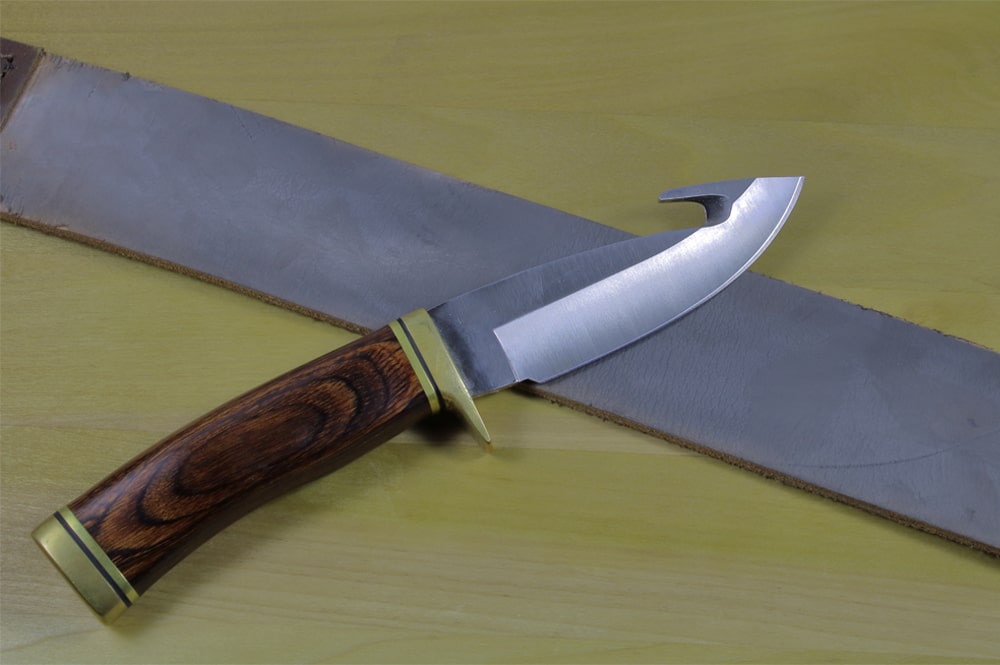Your Cart is Empty
Free US Shipping
Free US Shipping
When it comes to kitchen knives, knowing how to sharpen them properly and correct the sharpening edge is essential for keeping them in good shape and extending their durability. A well-sharpened knife is a necessary tool, especially for avid fans of cooking.
Stropping and honing are two methods used for maintaining and correcting the sharpness and edge of a knife. Stropping and honing are processes that follow the actual sharpening of a knife, rather than being the sole methods for sharpening.
In this article, we will compare stropping and honing to sharpening, discuss the differences between the two, and talk about which method is generally preferable. Plus, we will cover the overall importance of keeping knives well-sharpened and additional techniques to consider.
Stropping and honing are both methods used to further sharpen and correct an already sharp blade edge. That is to say, neither of these is used for the actual process of sharpening a knife from the point of it being dull.
Here are a few quick definitions to better illuminate how stropping, honing, and sharpening differ:
As such, before honing or stropping can be completed, you must first understand what maintenance your knives are in need of. In most cases where the owner of a knife is unaware of the different methods of knife maintenance, the knife may require an entire re-sharpening process before it can be either honed or stropped.
Oftentimes, the sharpening and honing processes are considered to be one in the same. However, this is not the case, and sharpening and honing should be viewed as two completely different processes, according to Lansky Sharpeners.
“It can get even more confusing because sharpening tools can also be called “hones”. The first step to learning the differences between sharpening and honing is simple; DON’T PANIC. It is easy to apply to both sharpening and honing because they use the same general techniques and skills.”
The reality is that there will be many similarities between all three processes of sharpening, honing, and stropping.
As previously mentioned, honing is a process employed on an already sharp knife used for the intention of maintaining the sharpness and quality of the blade. When knives are initially purchased, they have been professionally sharpened by a manufacturer. Over time, this sharpness wears to dullness, and the knife’s edge gradually becomes less straight and more worn from scratches and knicks as well.
Luckily, honing is a simply and fairly easy process that can be done at home without a ton of extra or expensive equipment. In fact, honing a knife is less about re-sharpening it and more about simply correcting the straightness of the edge. Honing re-alligns the blade, rather than sharpens it but will feel sharper due to the realigned blade. We recommend honing a knife every time you use it.
There are two main ways in which a knife can be honed – with either a honing steel or a knife pull-through. Honing steels are long, narrow, and rod-like tools made of metal. They are sometimes referred to as “sharpening steels”; however, this incorrectly implies that the rod can sharpen the knife. Instead, the honing steels help to keep the edge of the knife straight.
To use a honing steel, the knife should be held with the sharp edges facing away from the hand holding the knife and the tip pointing slightly upwards so that the back end of the edge is touching the steel, and with the side of the knife at approximately a fifteen degree angle against the steel.
The knife should then be slid down the steel while maintaining pressure in a sweeping motion so that the entirety of the edge comes into contact with the steel by the end of the motion.
Here’s a short and easy to follow video on how to use a honing steel:
Stropping a knife is often the final process of polishing a knife and removing any remaining imperfections or irregularities that may be left over after the sharpening or honing process.
As mentioned, when a knife is sharpened a wire edge is created, also known as a burr. The honing process then works to eliminate the burr. However, microscopic inconsistencies can remain – this is where stropping comes in.
According to Knife Sharpening Seattle:
“Once a knife edge has been honed, the newly restored edge has small imperfections and the "micro teeth" along the edge are more aggressive. Stropping will help refine the edge and realign the micro teeth. Stropping after honing will make a sharp edge even sharper for precise, controlled cuts.”
The actual tool used in the stropping process is called a strop. Strops are most commonly made from either suede or smooth leather, though other materials are used in some cases.
When it comes to choosing whether to use a suede or smooth strop, it ultimately depends on two factors – if a compound is being used and personal preference. Suede strops are more commonly used when a compound is also being utilized. Additionally, some prefer a more rounded bevel which the suede strop's softer surface provides.
This brings us to compounds being used during stropping. Stropping compounds are polishing agents that generally come in a block form and can be spread across the leather of the strop before beginning the stropping process.
While using a compound is not a requirement of the stropping process, the compounds help to refine the blade to an even more precise level, as well as provide a much more polished and mirror-like finish to the blade.
As for actually using the strop, the process is similar to that of using the honing steel. The knife should be held with the spine facing outwards in the direction the knife will be moved, with the edge touching the leather at a maximum of a 45 degree angle. Like with honing, the knife should then be slid across the strop in a sweeping motion.
Here’s a good video on how to properly use a strop:
When it comes to choosing between honing or stropping a knife, it is important to understand how to observe your knives for wear and tear in order to know when they need to be maintained. It is generally claimed that knives should be honed after every use, as the blade’s edge will become more dull and less straight each time it is put to use.
As such, more often than not, your knives should be honed rather than stropped, as honing is a necessary practice that will keep knives sharp and durable for a much longer period of time. Stropping, by comparison, does not necessarily need to occur after every use of the knife.
Over time, however, the consistent honing of the knife will eventually need to be refined more precisely – thus, providing the window of opportunity for stropping.
In some cases, knife owners will choose stropping over honing. It ultimately comes down to personal preference when it comes to which method a person should use. However, it should be noted that using a strop to hone a knife will take considerably longer than using a steel rod.
Comparatively, in terms of aesthetic purposes, only using the honing method and not the stropping method will result in knives not having as polished or as precise of a finish compared to when both methods are employed.
There are a few ways to test knives in order to see how dull they are becoming. One popular method is to take a sheet of regular printer paper and try slicing it down the middle with a knife while holding the paper up in the air. When slicing the paper, watch for these signs:
Though the paper test is an effective way of observing when a knife has become dull, the user of the knife is likely to notice before performing that test if they cook regularly. The dullness of a knife will become most apparent when chopping vegetables with an outer skin, such as tomatoes and bell peppers.
When a knife is dull, cutting through this skin will be incredibly difficult, and the blade is likely to slip off the skin.
We’ve already discussed to a degree why knives need to be regularly maintained. The primary reason is that knives that are not regularly honed and stropped will dull much quicker, losing their sharpness and straightness of the blade sooner.

However, there are also other consequences to allowing a knife to become dull. As mentioned, dull knives will not be able to chop vegetables as effectively, especially when it comes to those with an outer skin.
This, in turn, can slow down the preparation stage of cooking enormously. It also poses a threat to the integrity of the ingredients, as much more pressure will need to be applied and thus potentially compromise the ingredient’s shape, structure, and texture.
Additionally, a dull knife also poses a safety threat. When a knife is dull and unable to easily slice through ingredients, this can cause the knife to slip. This poses quite the risk to the user’s hand and fingers, as they may also be applying extra pressure which will cause more velocity as the knife slips. Thus, the user’s hands and fingers become massively at risk of being injured and sliced on accident.
Knives are necessary tools of the kitchen and should be treated with respect and caution. Just as you should not ignore the check engine light in your car, so should you not ignore the quality of your knife’s blade.
We have covered the similarities, differences, and purposes of honing and stropping knives, as well as the importance of utilizing these methods to maintain your knives’ edges from becoming too dull. We will now briefly cover what to do if a knife is past the point of being saved by honing, and how you can sharpen your knives from your own home.
The reality is that it may be fairly difficult to get a knife back to its original sharpness that it had when it was fresh out of the manufacturing facility. However, it is not impossible to re-sharpen a knife back to its original quality, it just takes some patience and the proper equipment.
Sharpening is a much more aggressive process that involves the reshaping of the blade, rather than just the refinement of it that is involved in both honing and stropping. In order to accomplish this, a material must be used that is harder than the metal from which the knife is crafted.
There are three main options when it comes to tools used for sharpening knives. They are whetstones, electric knife sharpeners, and manual knife sharpeners. All of these tools can be effectively used to sharpen a dull knife, however, there are some key differences between each.

Keeping kitchen knives sharp and maintaining the edges of the blade are essential components of any kitchen routine. Knives in general are highly useful tools that need to be well respected and maintained in order to be at their most efficient.
Honing and stropping are two methods to ensure your kitchen knives stay at a high quality and do not become dull or less durable too quickly. While consistent stropping is not necessary and is often more for aesthetics, honing is recommended after every use of a knife. When completed together, these two processes allow for knives to be at their ideal sharpness and blade quality for much longer.
Plus, the tools needed for honing and stropping are generally less expensive than sharpening tools. Therefore, by consistently honing and stropping your kitchen knives you can not only maintain your knives better, but also potentially save money on equipment.
